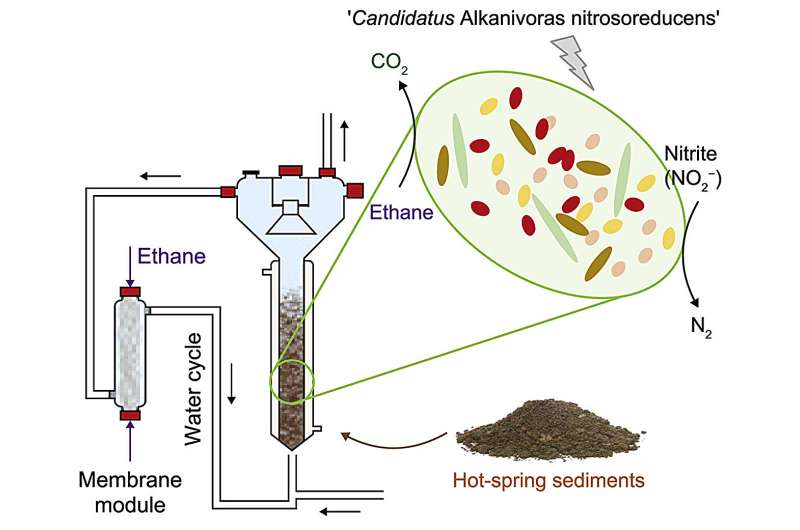This article has been reviewed according to Science X's editorial process and policies. Editors have highlighted the following attributes while ensuring the content's credibility:
fact-checked
proofread
Study finds nitrite-driven anaerobic ethane oxidation in microbial cultures

Ethane, an overlooked greenhouse gas, can be oxidized with electron acceptors like sulfate and nitrate. Despite nitrite being a more thermodynamically feasible electron acceptor, little is known about nitrite-driven anaerobic ethane oxidation.
In a study published in Environmental Science and Ecotechnology, a microbial culture capable of nitrite-driven anaerobic ethaneoxidation was enriched through long-term operation of a nitrite-and-ethane-fed bioreactor. During continuous operation, the nitrite removal rate and the theoretical ethane oxidation rate remained stable at approximately 25.0 mg NO2–N L−1 d−1 and 11.48 mg C2H6 L−1 d−1, respectively.
Batch tests demonstrated that ethane is essential for nitrite removal in this microbial culture. Metabolic function analysis revealed that a species affiliated with a novel genus within the family Rhodocyclaceae, designated as Candidatus Alkanivoras nitrosoreducens, may perform the nitrite-driven anaerobic ethane oxidation. This novel genus is described in full in the paper.
Based on a meta-omic analysis, Ca. A. nitrosoreducens encoded and expressed a prospective fumarate addition pathway for anaerobic ethane oxidation and a complete denitrification pathway for nitrite reduction to N2, although the genes for ethane conversion to ethyl-succinate (assAs) and succinate-CoA ligase (sucCD) required further identification.
Phylogenetic affiliation analysis showed a distant genetic relationship between Ca. A. nitrosoreducens and the previously reported Candidatus Alkanivorans nitratireducens that was capable of nitrate-driven anaerobic ethane oxidation, which suggests functional microbial differences in different natural environments.
This study offers new evidence of nitrite-driven anaerobic ethane oxidation occurring in enriched cultures from hot-spring sediment, and describes a novel genus potentially involved in this process.
These findings advance our understanding of nitrite-driven anaerobic ethane oxidation, highlighting the previously overlooked impact of anaerobic ethane oxidation in natural ecosystems.
More information: Cheng-Cheng Dang et al, Nitrite-driven anaerobic ethane oxidation, Environmental Science and Ecotechnology (2024). DOI: 10.1016/j.ese.2024.100438
Provided by Eurasia Academic Publishing Group





















